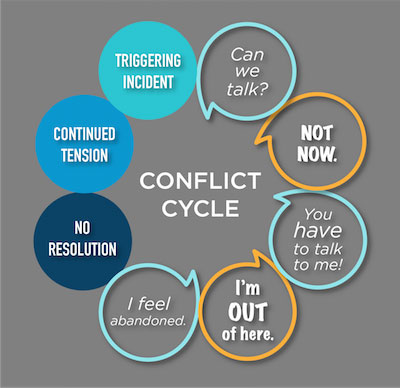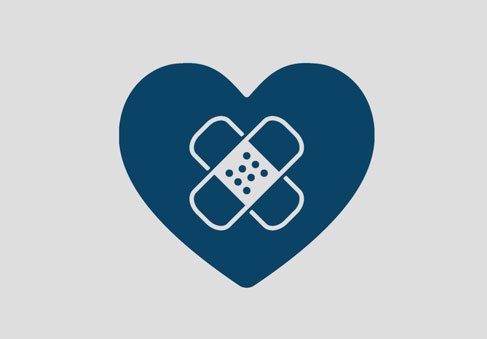An attachment injury is an emotional wound to an intimate, interdependent relationship. It usually happens after a breach of trust—particularly in a time of need or a moment of loss or transition. Once an attachment injury occurs, it can leave one or both partners feeling betrayed or abandoned.
 Like a physical injury, an attachment injury is usually the result of a specific incident. The incident could be something obvious such as an infidelity. Or the injury could be caused by one partner’s unexpected reaction to a pregnancy or miscarriage, or a diagnosis such as cancer, traumatic brain injury (TBI), or post-traumatic stress disorder (PTSD). An attachment injury also could be more subtle and seemingly insignificant, such as being left out of a family photo, not getting a “happy anniversary” call during a deployment, or having a deployment homecoming experience that falls short of what one of you expected.
Like a physical injury, an attachment injury is usually the result of a specific incident. The incident could be something obvious such as an infidelity. Or the injury could be caused by one partner’s unexpected reaction to a pregnancy or miscarriage, or a diagnosis such as cancer, traumatic brain injury (TBI), or post-traumatic stress disorder (PTSD). An attachment injury also could be more subtle and seemingly insignificant, such as being left out of a family photo, not getting a “happy anniversary” call during a deployment, or having a deployment homecoming experience that falls short of what one of you expected.
What are the effects?
When an attachment injury isn’t repaired, feelings of betrayal or abandonment can keep coming back to create conflict between you and your partner. The impact can snowball too. For example, if one partner continues to discount, deny, or dismiss the significance of the injury, it can make the wound deeper. The injured partner might become even more distant or repeatedly ask themselves, “Can I depend on or trust this person?” Meanwhile, the other partner might feel angry or frustrated, or think their partner should just “get over it.”
When this pattern is repeated, it can really damage relationships in the long run, much like continuing to run on a sprained ankle rather than resting it. But with proper care, treatment, and time, you can get back to your pre-injury relationship health or grow even stronger than before.
Tips for injury prevention
Just as with physical injuries, prevention is key when it comes to attachment injuries. Attachment injuries are often about how one partner reacts in a particular moment, so it’s important to pay special attention to how you respond to each other.
- Slow down and shift your focus before you respond to your partner, especially in times of excitement or distress.
- Remember to validate your partner’s feelings and show you understand.
- Train to optimize your relationship by practicing behaviors such as effective expression, accountability, and respect.
- Maintain openness through effective listening, hearing, and other basic communication skills.
Want to learn more about avoiding attachment injuries? Check out our strategies to avoid “argument traps.”
How to recognize whether an injury has occurred
Remember, it’s normal for relationships to have ups and downs; not all conflicts are the result of an attachment injury. Some signs of an attachment injury include:
- A specific event fundamentally shifts your view of your partner or the way he or she views you.
- You feel you’re at an impasse in your relationship that can’t be overcome.
- You or your partner resist being vulnerable or looking to one another for comfort.
- You or your partner experience signs of trauma, such as hypervigilance, intrusive memories of the original incident, avoidance, or numbness.
- You experience emotional pain each time you need to trust or depend on your partner.
Strategies for recovery
Sometimes you might feel there’s no way to recover from a betrayal or an attachment injury. The good news is, your relationship can survive, heal, and even grow stronger as a result. Try these strategies:
Take care of yourself first. Attachment injuries often occur in times of transition (such as leaving for or returning from deployment) and in times of physical or imminent danger (such as being in combat). You might need to take some time to sort through and stabilize your own feelings before starting sensitive conversations with your partner.
Avoid compound fractures. Remember how easily unhealed wounds can be made worse without proper care. Once you and your partner start to repair the injury, even if you can’t resolve the issue on your first try, do your best to validate each other’s feelings and avoid the snowball effect that can make the damage worse.
 Map your conflict cycle. Attachment injuries take time to heal, so start slowly and shift your interactions a little bit at a time. A great first step is to think about how the injury creates conflict in your relationship. Chances are, the conflict follows a common pattern that becomes a cycle. Think about how conversations typically start, what causes them to get off track, and how you and your partner likely respond to each other. You can make huge strides by making small shifts in your pattern, focusing on understanding, and avoiding argument traps.
Map your conflict cycle. Attachment injuries take time to heal, so start slowly and shift your interactions a little bit at a time. A great first step is to think about how the injury creates conflict in your relationship. Chances are, the conflict follows a common pattern that becomes a cycle. Think about how conversations typically start, what causes them to get off track, and how you and your partner likely respond to each other. You can make huge strides by making small shifts in your pattern, focusing on understanding, and avoiding argument traps.
Focus on forgiveness. Regardless of what the original injury might have been, over time, both you and your partner will likely feel hurt. Remember, you both played a role in keeping the negative patterns going before you came together to fix things and heal. It’s also important that you focus on forgiving each other so you can move forward. Consider trying a forgiveness mediation to get in the right mindset.
Seek support. One size doesn’t fit all, and even with tips like these to get you started, you and your partner might need some extra help. Just as you would see a doctor or physical therapist for a physical injury, consider reaching out to a professional to help repair your attachment bond.
Bottom line
When you let yourself be emotionally close and vulnerable with another person, there’s always a chance you might hurt each other, even by accident. By taking the time to understand and treat attachment injuries, you can help keep yourself and your relationships strong, healthy, and optimized.
